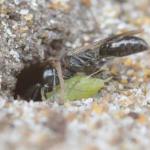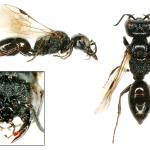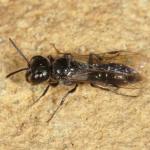Widespread in England, north to north-east Yorkshire; sporadic in Wales and very restricted in Scotland, from where there is only a single record. The species is absent from Ireland, but present on Guernsey and Sark in the Channel Islands.
Common throughout Europe, also found in Asia: Kazakhstan and Mongolia (Lomholdt 1975-76).
Not regarded as threatened, although Richards (1980) considered it not very common.
Occurs in sandy places, including heathland, sand/gravel pits and hedge-banks.
Late May to mid October, but particularly July and August. There may be more than one generation per year.
Wingless aphids, such as Hyalopterus pruni (Lomholdt 1975-76). The prey is not stung but malaxated (the body is chewed to release fluids which are then imbibed) in the thoracic region.
The nest is constructed in dry, sandy soil, often in sloping or vertical faces. The burrow may be multi-branched and have more than 20 cells. Each cell contains 20-40 prey and when the larva has consumed these, it spins a firm cocoon which is covered outside with attached sand grains (Lomholdt 1975-76).
Visits to flowers are not known for this species, but it may visit honeydew.
The mutillid wasp Myrmosa atra is recorded as a parasitoid (Lomholdt 1975-76). (see also Edwards 1998).
2002




